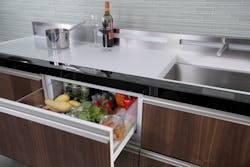As Millenials make their move from the suburbs back into the city and Baby Boomers retire to smaller living spaces, GE Appliances is finding new opportunities in kitchen design, challenging its developers to come up with more compact, space-efficient, flexible technologies for the micro-kitchen of the future.
Yes, I know… With Automation World rooted firmly in the industrial automation space, you don’t usually see us discussing the latest in home appliances. But it’s interesting to note the similarities in demands for technology—getting all the features into smaller spaces, for example; building Wi-Fi into instruments; or finding better, more intuitive ways to display information.
Industrial manufacturing can always learn from developments in other industries. In fact, look for a series of articles from us in the coming year on lessons learned from thrill rides, building automation and more.
Nonetheless, what is arguably most interesting from a manufacturing perspective at GE Appliances these days is FirstBuild, an online and physical community that is partnering not only with cutting-edge companies like MakerBot, TechShop, Local Motors and LVL1, but also with an online community in a crowdsourcing methodology of home appliance innovation.
Through its partnership with Local Motors, GE created a manufacturing model that pairs co-creation and micromanufacturing with a focus on speeding the time from mind to market. At its recent grand opening of the FirstBuild Microfactory in Louisville, Ky., Kevin Nolan, vice president of technology for GE Appliances, described the “game changing way to design and build products.” At the core of the FirstBuild model is an online co-creation community and micromanufacturing that together enable faster development, testing, customization and small-batch production.
At FirstBuild.com, community members (whether engineers or users, experts or not) can submit ideas, vote on which concepts become challenges or projects, and decide which products will move on to production. “We will unlock creative minds around the world,” said Venkat Venkatakrishnan, director of R&D for GE Appliances. “We’re going to change the way appliances are designed, conceived, made and sold.”
In one innovation challenge, community members were tasked with designing a full kitchen suite within 6 linear feet. The Micro-Kitchen Challenge has produced five finalists from around the world—the Slovak Republic; Guadalajara, Mexico; Buenos Aires, Argentina; Seattle; and Arizona. The latest challenge is to bring outdoor grilling indoors.
And from wherever you are around the world, Venkatakrishnan noted, the online community can watch the products being built at the Microfactory. GE Appliances showed some of the community-driven innovations that are being made at FirstBuild already.
The Smart Pitcher, for example, keeps a pitcher of cold water always at the ready inside a GE refrigerator. When the pitcher sits underneath the level-sensing dispenser, cold water fills the pitcher and stops automatically. An upgrade planned for this fall will also include filtration.
Bre Pettis, founder and CEO of MakerBot, demonstrated how his company’s 3D printing machines are creating the key components of the Smart Pitcher. “3D printing allows you to innovate faster, and compress your innovation cycle,” he said.
LineCook has become FirstBuild’s first community-led project with commercial availability pending. Designed to eliminate the variability that produces overcooked and undercooked food, the idea gained traction through a project introduced by hackerspace LVL1. The oven scans the barcode of prepared foods and automatically sets the cooking method, time and temperature.
Chris Cprek, LVL1 co-founder, described a hackathon in which the LVL1 community essentially tried to figure out how to make the oven do tricks, finding answers to such question as: “How fast can we possibly cook this burrito?”
GE is also partnering with TechShop to equip the Microfactory with milling machines, waterjet cutters and other equipment at an accessible cost. TechShop operates a growing national chain of public access workshops, providing tools, software and space for creative communities.
Access to tools is “a seminal moment in the development of the next industrial revolution,” said Mark Hatch, TechShop’s CEO, speaking at the FirstBuild Microfactory opening. “When people can come in here and make a product for $1,000, $2,000, you have fundamentally changes the rules. You enable anybody to innovate.”
Located on the University of Louisville campus, the FirstBuild Microfactory is also a place for students to get hands-on experience in a manufacturing environment. “They can take what they learned in the classrooms and apply it here,” said James Ramsey, the university’s president. “They will get the very best in theory from us, but they need to be able to apply it.”
About the Author
Aaron Hand
Editor-in-Chief, ProFood World

Leaders relevant to this article:
